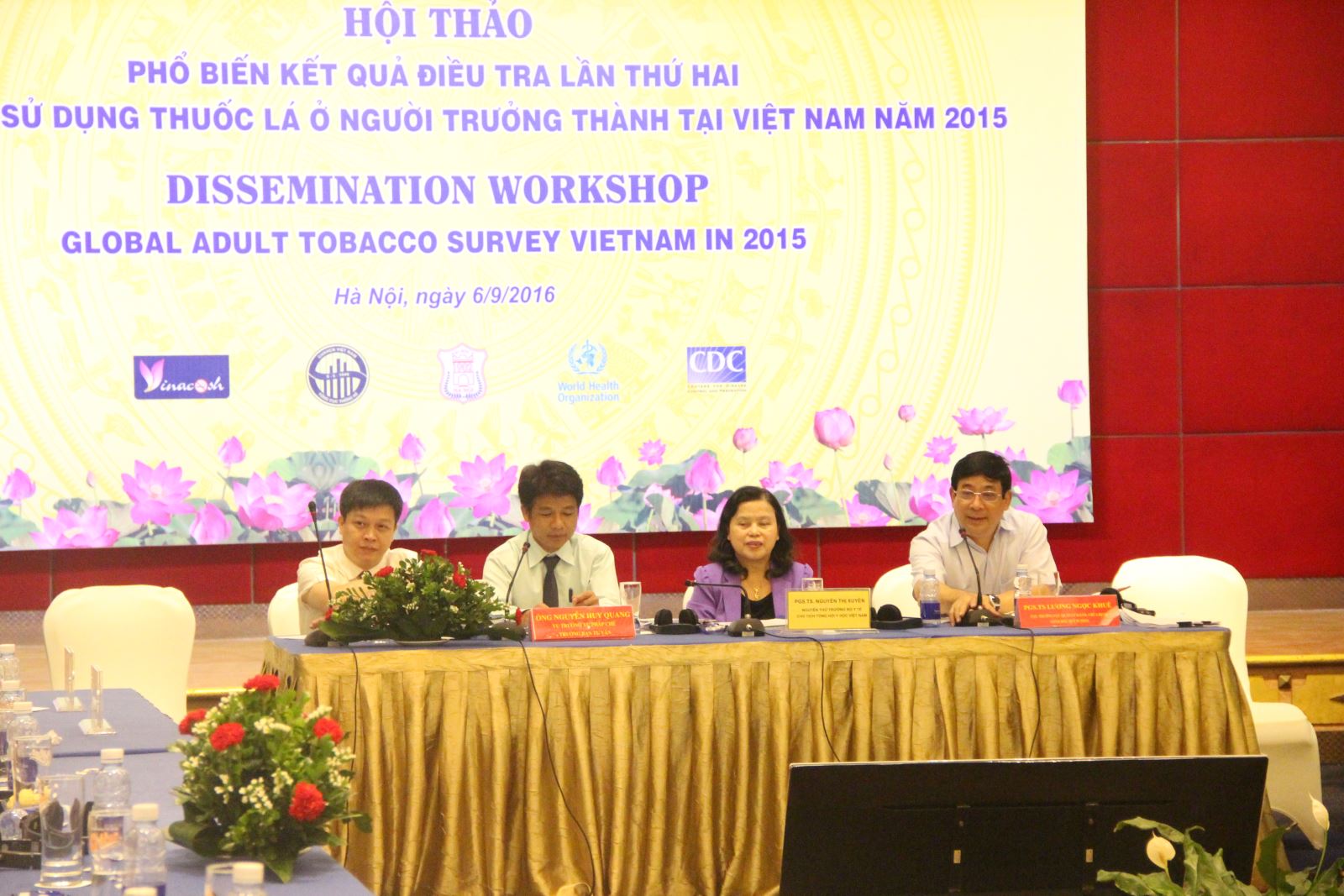
Ministry of Health Vietnam S.R release the report of Global Adult Tobacco Survey
Updated at 07 Sep 2016, 14:43
(Hanoi, Vietnam)- 6th September 2016, the Ministry of health of Vietnam launched the national workshop for dissemination of report of Global Adult Tobacco Survey (GATS) in 2015. It is the second repeat of GATS in Vietnam (firstly conducted in 2010).

The survey has revealed some followed findings:
- The smoking prevalence tended to be lower compared with 2010 for overall (23.8% in 2010 vs 22.5% in 2015) and among men (47.4% vs 45.3%) and among women (1.4% vs 1.1%).
- The smoking prevalence of any cigarette significantly declined for overall from 19.9% in 2010 to 18.2% in 2015
- The overall smoking prevalence of any smoked tobacco product in urban area significantly decline from 23.3% in 2010 to 20.6% in 2015. In which, this prevalence in men was 47.7% in 2010 and 42.7% in 2015.
- The smoking prevalence of any cigarette among men in urban significantly decline from 45.2% in 2010 to 38.7% in 2015.
- The prevalence of indoor secondhand smoke (SHS) exposure in most places significantly declined from 2010 to 2015, including in the home (73.1% to 59.9%), workplace (55.9% to 42.6%), universities (54.3% to 37.9%), public transportation (34.4% to 19.4%), and schools (22.3% to 16.1%).
- The proportion of current smokers who received advice to quit by a healthcare provider when visiting health facilities increased from 29.7% in 2010 to 40.5% in 2015.
- There was no increase in quitting smoking as the proportion of former smokers among ever smokers remained unchanged from 2010 to 2015 (29.3% and 29.0%, respectively).
- There was an increase in the public’s awareness about the harmful health effects of smoking and exposure to SHS between 2010 and 2015.
- The proportion who believed smoking causes stroke, heart attack, and lung cancer significantly increased from 2010 to 2015 (55.5% to 61.2%).
- The proportion who believed SHS causes serious illness to non-smokers significantly increased from 2010 to 2015 (87.0% to 90.3%).
- The percentage of persons aged 15-24 years who reported noticing cigarette advertising and promotions significantly declined between 2010 and 2015 (25.3% to 19.8%).
- The average amount paid for 20 manufactured cigarettes tended to be lower (12,700 VND in 2010 after adjusting for inflation; 11,800 VND in 2015).

The GATS results would be essentially for evidence based policy development and proposing the next proper interventions. It shown the progress has been made in implementing smoke-free policies resulting in the reduction of SHS exposure in Viet Nam. However, exposure to SHS remains high in homes, at workplaces, and in public places, especially inside restaurants (80.7%). 100% smoke-free policies and enforcement in public areas such as restaurants, bars, and coffee/tea shops, can reduce involuntary SHS exposure indoors. Thereof, it should continuously implementing comprehensive tobacco control efforts can significantly reduce the tobacco smoking prevalence.
In addition, increasing the tax and price of tobacco products is an evidence-based strategy proven to reduce consumption. Because the tobacco tax has only been increased slightly, it has not impacted the overall price of tobacco. Increasing the tax high enough will assist in reducing the affordability of tobacco.
Otherwise, monitoring and enforcing comprehensive prohibitions on tobacco advertising, promotion, and sponsorship (TAPS) can help protect youth from TAPS exposure, especially at points-of-sale.
It is important for communication activities to continue to be strengthened in order to sustain and increase public awareness about the dangers of tobacco use and toward changing smoking behaviors.
Implementation of cessation services or programs can encourage and support smokers to quit.
VINACOSH and Ministry of Health acknowledge the contributions from international partners to conduct the survey. The financial support was provided by the Bloomberg Initiative to Reduce Tobacco Use through the CDC Foundation with a grant from Bloomberg Philanthropies and the Bill & Melinda Gates Foundation. Technical assistance was provided by the Centers for Disease Control and Prevention (CDC), the World Health Organization (WHO), and RTI International. Program support was provided by the CDC Foundation.
In addition, increasing the tax and price of tobacco products is an evidence-based strategy proven to reduce consumption. Because the tobacco tax has only been increased slightly, it has not impacted the overall price of tobacco. Increasing the tax high enough will assist in reducing the affordability of tobacco.
Otherwise, monitoring and enforcing comprehensive prohibitions on tobacco advertising, promotion, and sponsorship (TAPS) can help protect youth from TAPS exposure, especially at points-of-sale.
It is important for communication activities to continue to be strengthened in order to sustain and increase public awareness about the dangers of tobacco use and toward changing smoking behaviors.
Implementation of cessation services or programs can encourage and support smokers to quit.
VINACOSH and Ministry of Health acknowledge the contributions from international partners to conduct the survey. The financial support was provided by the Bloomberg Initiative to Reduce Tobacco Use through the CDC Foundation with a grant from Bloomberg Philanthropies and the Bill & Melinda Gates Foundation. Technical assistance was provided by the Centers for Disease Control and Prevention (CDC), the World Health Organization (WHO), and RTI International. Program support was provided by the CDC Foundation.